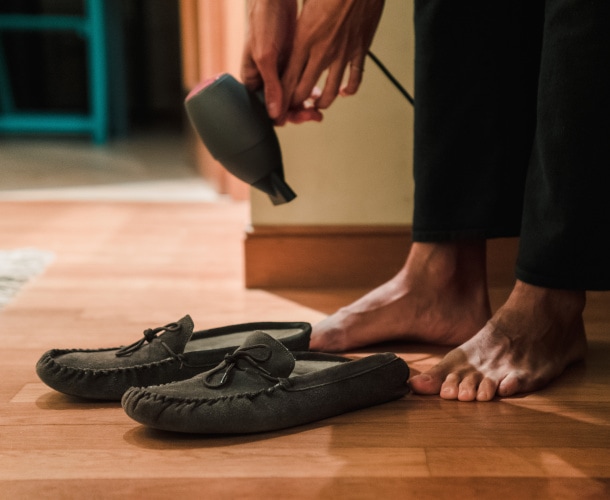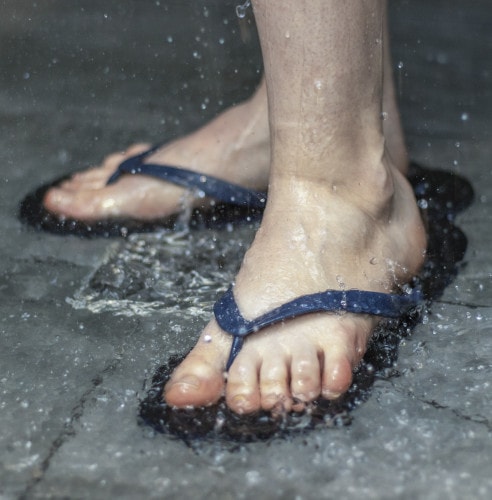Toenail fungus, as the name implies, is an infection that affects the toenails. It can spread quickly and be difficult to get rid of, which is why your best option is to take steps to prevent it in the first place.
Read on to learn more about how to prevent fungal nail infections and whether blow-drying your feet can make a difference.

Understanding toenail fungus
Toenail fungus – or foot fungus – is a type of fungus that gets underneath your nails. It usually causes discoloration and brittle nails. Professionals call this condition onychomycosis. If left untreated, fungus can cause the nail to separate from the nail bed.
While athlete’s foot is a different condition, this common skin infection often leads to infected nails since the same type of fungus causes both conditions.
There are different toenail fungus treatment options depending on your specific circumstances:
- You can take oral medications to support your immune system and fight off the infection or nail fungus.
- Over-the-counter antifungal products, including antifungal sprays, topical creams, and antifungal powder, are sometimes useful in treating toenail fungus.
- Medicated nail polish is another good option if you have a mild case of toenail fungus or want to prevent toenail fungus from coming back.
- There are some home remedies like essential oils that can help to a certain extent.
If you’re having a hard time getting rid of a severe case of fungal infection, it’s best to schedule an appointment with a Doctor of Podiatric Medicine (DPM). A podiatrist will be able to prescribe a treatment or use advanced methods like laser treatments.
How to Prevent Toenail Fungus
You can prevent toe fungus by keeping your feet dry, protecting your feet in shared shower facilities, and adopting good hygiene.
Use a Blow Dryer

Fungi are a type of mold. They thrive in warm, moist environments. Because the skin between your toes and underneath your nails can trap and retain moisture, these spots are ideal candidates for toenail fungal infections.
Using a blow dryer when getting out of the shower, bath, or swimming pool is a great way of preventing toenail fungus. It only takes a few seconds to dry in between toes, and you can also target the toenails.
If you’re unsure of how to dry your toes, the best way to do it is to keep the blow dryer a few inches away from your skin to avoid pain and discomfort. Angle the blow dryer to target the top of your feet before doing the same thing for the bottom of your feet. You can then angle the blow dryer to face your toes and dry the spots between your toes as well as the toenails. Use back-and-forth motions to make sure you’re drying all your toes evenly.
How long do toes take to dry with a blow dryer? You should be able to dry your feet completely within 30 seconds per foot.
If you have diabetic neuropathy, be careful using this technique so you don’t accidentally burn your feet with the hot air.
Avoid Using a Towel
Using a towel to absorb moisture beats putting your socks and shoes on while your feet are still wet. However, a towel isn’t the best way to prevent toenail fungus.
How do you get toe fungus? It’s important to understand what causes toe fungus. You’ll typically pick up spores when walking on wet floors, especially in locker rooms and public showers.
The spores will then grow and thrive if they’re in a dark, damp, and warm environment. Drying with a towel is not a good idea because your towel could become the perfect breeding ground for fungal spores.
You could accidentally spread these spores to other areas of your body and develop athlete’s foot, skin infections, or psoriasis.
Plus, drying with a towel makes you more likely to miss spots. Most people will not take the time to wipe the moisture between their toes when using a towel.
If you have to use a towel, wash it regularly and use a separate towel for your feet if possible.
Don’t Air Dry Your Feet
Air drying your feet isn’t a good option since it could take as long as 30 minutes before your feet are completely dry. Plus, if you’re at the gym, you’ll probably spend this time walking around the locker room, which means you could pick up bacteria and spores.
Plus, if you picked up fungal spores in the showers, the 30 minutes you spend air drying your feet will give these spores plenty of time to start spreading.

Wear Shower Shoes
Shower shoes for the gym will protect your feet. Don’t walk barefoot in public areas, instead wear flip-flops or non-slip shower shoes to prevent direct contact with the floor.
Shower shoes can prevent contact with fungal spores and will also protect you from the bacteria that causes plantar warts.
Use Proper Hygiene
Taking good care of your toes and nails can go a long way in protecting you from fungal infections. Trimming your nails too short, having ingrown nails, or waiting too long between trims can create points of entry for fungus.
Give yourself a pedicure at home at least every six weeks. Use a nail clipper to trim your nails straight across, and don’t round the edges.
Washing your feet is also important. Use an antibacterial soap and consider using a soft-bristled brush to scrub between your toes if you are prone to getting athlete’s foot.
When visiting a nail salon, make sure they’re following proper sanitizing procedures. Improper tool cleaning can spread toenail fungus from one salon client to another.
Pick Appropriate Footwear
Wearing shoes that fit properly can reduce the risk factors that make you more likely to develop infections and other issues.
If you’re an athlete, wear shoes with a moisture-wicking liner that can keep the sweat away from your skin. Mesh shoes are a must-have when training in the summer. Ideally, you should have more than one pair of shoes so you can rotate them and wash them as needed.
An ounce of prevention is worth a pound of cure
Toenail fungus can be difficult to get rid of if you let the infection spread. However, preventing it takes only a few easy steps.
Start by blow-drying your feet to prevent moisture from getting trapped between your toes and underneath your nails. Good hygiene and wearing the proper footwear, including shower shoes, can also go a long way in preventing fungal infections.
Why choose University Foot and Ankle Institute for your foot and ankle care?
Whether you need to find proper footwear, treat an injury, or get advice on proper foot care, we’re here to help. Our podiatrists offer the most advanced podiatry care and the highest success rates in the nation. We are nationally recognized foot and ankle specialists and leaders in researching, diagnosing, and treating all foot and ankle conditions and common injuries.
For a consultation please call (877) 736-6001 or make an appointment online now.
Our podiatrists take patients’ safety seriously. Our podiatry facility’s Covid-19 patient safety procedures exceed all the CDC’s coronavirus pandemic recommendations. Masks are always required in our institutes.
University Foot and Ankle Institute is conveniently located throughout Southern California and the Los Angeles area. Our foot doctors are available at locations in or near Santa Monica, Beverly Hills, West Los Angeles, Manhattan Beach, Northridge, Downtown Los Angeles, Westlake Village, Granada Hills, and Valencia.
- Is Bunion Surgery Covered By Insurance? - January 28, 2025
- Top 10 Non-Surgical Treatments for Morton’s Neuroma - January 20, 2025
- Moore Balance Brace: Enhance Stability and Prevent Falls for Better Mobility - December 16, 2024
Leave a Reply